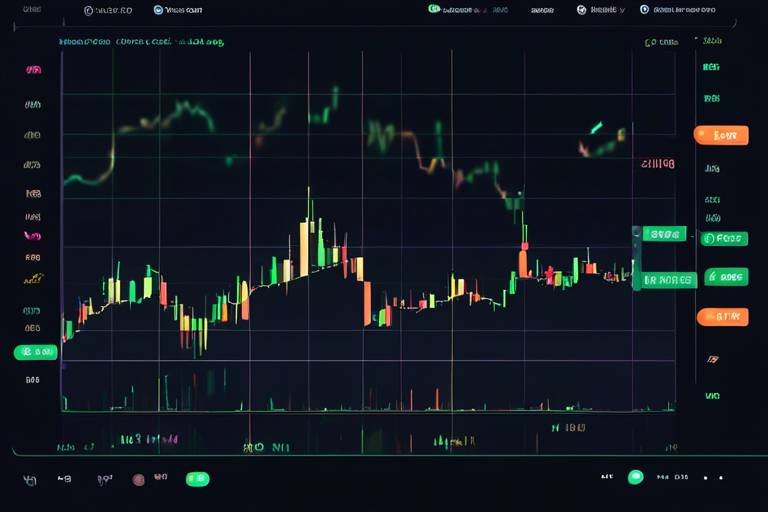How to Develop a Winning Mindset for Trading
Trading is not just about numbers and charts; it’s a mental game that requires a winner's mindset. If you want to succeed in the trading world, you need to cultivate a mindset that can withstand the ups and downs of the market. Think of trading like surfing: you can’t control the waves, but you can learn to ride them. In this article, we will explore essential strategies for developing a winning mindset, focusing on psychological resilience, discipline, and effective decision-making. Let’s dive into the world of trading psychology and unlock the secrets to becoming a successful trader.
Before you can become a successful trader, it’s crucial to understand the psychological factors that influence your trading decisions. Have you ever made a trade based on fear or greed? You’re not alone! Many traders fall victim to common cognitive biases, such as overconfidence or loss aversion. Recognizing these biases is the first step toward managing them. For instance, when you experience a string of wins, it’s easy to feel invincible and make impulsive decisions. Similarly, a series of losses can trigger emotional responses that cloud your judgment. By being aware of these emotional triggers, you can make more rational decisions and improve your trading performance.
Discipline is the backbone of successful trading. Without it, you might find yourself succumbing to the whims of the market, making impulsive decisions that can lead to significant losses. To maintain discipline, it’s essential to set clear rules and adhere to a well-defined trading plan. Think of your trading plan as your roadmap; it guides you through the turbulent waters of the market. By sticking to your plan, you can mitigate the risk of emotional trading and stay focused on your long-term goals.
A well-structured trading plan is vital for success. It should encompass several key components:
- Risk Management: Determine how much of your capital you are willing to risk on each trade.
- Entry and Exit Strategies: Define your criteria for entering and exiting trades.
- Performance Evaluation: Regularly assess your trading outcomes to identify areas for improvement.
Having these components in place can help you navigate the markets with confidence and clarity.
Establishing achievable goals is crucial for maintaining focus and motivation. Setting both short-term and long-term goals aligned with your trading style and risk tolerance can keep you on track. For example, a short-term goal might be to increase your trading account by 5% over the next month, while a long-term goal could be to achieve consistent profitability over the year. These goals act as benchmarks, guiding your trading journey and helping you measure your progress.
Regularly reviewing and adjusting your trading plan is essential for continuous improvement. Just like a seasoned chef tastes their dish and adjusts the seasoning, you need to analyze your past trades to make necessary adjustments. Look at what worked, what didn’t, and why. This reflection will help you refine your strategies and enhance your future performance.
Emotional resilience is critical for handling the inevitable ups and downs of trading. It’s about developing a strong mindset that can withstand market fluctuations and setbacks. One effective strategy is to practice self-compassion. Instead of beating yourself up over a loss, treat yourself with kindness and understand that setbacks are part of the learning process. Additionally, engaging in activities outside of trading, such as exercise or hobbies, can help you maintain a balanced perspective and reduce stress.
Incorporating mindfulness and stress management techniques can significantly enhance a trader's performance. Mindfulness involves being present in the moment and can help you stay focused during high-pressure trading situations. Techniques such as meditation and breathing exercises can reduce anxiety and clear your mind, allowing you to make more rational decisions. Imagine being in a calm oasis amidst a storm—this is the mindset you want to cultivate while trading.
Visualization can be a powerful tool for traders. By using mental imagery, you can prepare for various market scenarios and reinforce confidence in your decision-making. Picture yourself executing a successful trade, feeling the excitement of a win. This mental rehearsal can boost your confidence and enhance your performance when the time comes to make real trades.
Having a support system can aid in developing a winning mindset. Connecting with mentors and peers allows you to share experiences and gain valuable insights. Consider joining trading communities or forums where you can discuss strategies and learn from others’ successes and failures. This collaborative approach can provide you with the encouragement and motivation needed to keep pushing forward.
- What is the most important aspect of a trading mindset?
The most important aspect is emotional resilience, which allows traders to handle market fluctuations and setbacks effectively.
- How often should I review my trading plan?
It’s advisable to review your trading plan regularly, ideally after each trading session or weekly, to identify areas for improvement.
- Can mindfulness really help in trading?
Yes! Mindfulness can reduce anxiety and help you maintain focus, leading to better decision-making in high-pressure situations.

Understanding the Psychology of Trading
When it comes to trading, the mind can be both your greatest ally and your worst enemy. Understanding the psychological factors that influence your decisions is crucial for success. Many traders underestimate the impact of emotions and cognitive biases on their trading performance. It’s like sailing a ship; if you don't understand the winds and currents, you might find yourself lost at sea. So, what are these psychological hurdles that traders face?
First, let's talk about cognitive biases. These are systematic patterns of deviation from norm or rationality in judgment. For instance, the confirmation bias leads traders to favor information that confirms their existing beliefs, ignoring any contradictory data. Imagine you’re convinced that a stock will rise; you might only seek out news that supports this idea while dismissing warnings about potential downturns. This can lead to poor decision-making and significant losses.
Another common bias is the loss aversion phenomenon, where the pain of losing is psychologically more impactful than the pleasure of gaining. This can cause traders to hold onto losing positions for too long, hoping they will rebound, instead of cutting their losses early. It’s a classic case of “throwing good money after bad” and can erode a trader’s capital over time.
Emotional triggers also play a significant role in trading psychology. Fear and greed are two powerful emotions that can lead to impulsive decisions. Fear can paralyze a trader, making them hesitant to enter a position even when the indicators are favorable. On the other hand, greed can push traders to take excessive risks, chasing after profits without proper analysis. It’s crucial to recognize these emotional responses and develop strategies to manage them.
To combat these biases and emotional triggers, traders must cultivate a strong sense of self-awareness. This involves regularly reflecting on your trading decisions and understanding the motivations behind them. Keeping a trading journal can be an effective way to track your thoughts and emotions during trades. By documenting your experiences, you can identify patterns in your behavior and make adjustments accordingly.
Furthermore, it’s essential to develop a mindset that embraces continuous learning. The market is constantly evolving, and what worked yesterday may not work today. By staying informed and adapting your strategies, you can mitigate the psychological pitfalls that come with trading. Remember, trading is not just about numbers and charts; it’s about understanding the human element behind those numbers.
In summary, understanding the psychology of trading is not just a nice-to-have; it's a fundamental aspect of becoming a successful trader. By recognizing cognitive biases, managing emotional triggers, and fostering self-awareness, you can enhance your trading performance and navigate the markets with confidence.
- What is cognitive bias in trading? Cognitive bias refers to the systematic patterns of deviation from norm or rationality in judgment, which can lead to poor trading decisions.
- How can I manage my emotions while trading? Practicing self-awareness, keeping a trading journal, and developing a trading plan can help manage emotions like fear and greed.
- Why is self-awareness important in trading? Self-awareness allows traders to reflect on their decisions and behaviors, helping them to identify and correct biases and emotional triggers.

The Importance of Discipline
Discipline is not just a buzzword; it’s the backbone of successful trading. Think of it as the sturdy ship that keeps you afloat during the stormy seas of the financial markets. Without discipline, you're likely to drift aimlessly, making impulsive decisions that can lead to significant losses. So, how do you cultivate this essential trait? It all starts with establishing a set of rules and sticking to them, no matter how tempting it may be to deviate in the face of market fluctuations.
One of the most effective ways to maintain discipline is by creating a well-defined trading plan. This plan serves as your roadmap, guiding you through the complexities of trading. It should include various components, such as:
- Risk Management: Determine how much capital you're willing to risk on each trade and stick to it. This helps prevent emotional decisions driven by fear or greed.
- Entry and Exit Strategies: Define clear criteria for entering and exiting trades. This takes the guesswork out of your decisions and allows you to act with confidence.
- Performance Evaluation: Regularly review your trades to identify patterns and areas for improvement. This self-assessment fosters accountability and ensures you’re learning from each experience.
Additionally, setting realistic goals is crucial for maintaining discipline. When your objectives are achievable, you're more likely to stay focused and motivated. For instance, instead of aiming to double your account in a month, consider setting a goal of a steady percentage increase over several months. This not only makes your targets more attainable but also helps build your confidence as you reach each milestone.
Another key aspect of discipline is the ability to review and adjust your trading plan regularly. The markets are constantly changing, and what worked yesterday may not work tomorrow. By analyzing your past trades, you can identify what strategies are effective and which ones need tweaking. This ongoing process of evaluation and adaptation is vital for continuous improvement and can significantly enhance your trading performance.
In summary, discipline is the cornerstone of successful trading. It involves creating a structured trading plan, setting realistic goals, and regularly reviewing your performance. By committing to these practices, you’ll find that your trading becomes more systematic and less prone to the emotional highs and lows that can derail your success.

Creating a Trading Plan
A well-structured trading plan is not just a document; it's your personal roadmap to success in the unpredictable world of trading. Imagine embarking on a journey without a map—sounds chaotic, right? That's precisely what trading without a plan feels like. A trading plan provides clarity and direction, helping you navigate the market's twists and turns. It serves as a guide that outlines your strategies, goals, and the rules you will follow, ensuring that you stay on course even when emotions run high.
When creating your trading plan, consider incorporating several key components. First and foremost, risk management is crucial. This involves determining how much of your capital you are willing to risk on each trade. A common rule of thumb is to risk no more than 1-2% of your total trading capital on a single trade. This strategy helps protect your account from significant losses and allows you to trade with confidence.
Next, you'll want to define your entry and exit strategies. Think of this as the "when" and "how" of your trades. What signals will you look for to enter a trade? Are you relying on technical indicators, fundamental analysis, or a combination of both? Similarly, establish clear exit points. Whether you're taking profits or cutting losses, knowing when to exit is just as important as knowing when to enter.
| Component | Description |
|---|---|
| Risk Management | Determine the percentage of capital to risk per trade. |
| Entry Strategy | Define the criteria for entering a trade. |
| Exit Strategy | Establish rules for taking profits or cutting losses. |
Additionally, don't forget to include a method for performance evaluation. This means regularly reviewing your trades to identify what worked and what didn’t. By analyzing your past performance, you can make informed adjustments to your plan, enhancing your trading skills over time. Remember, a trading plan is not set in stone; it should evolve as you gain experience and as market conditions change.
In summary, a trading plan is your best friend in the trading world. It helps you stay disciplined, minimizes emotional decision-making, and ultimately enhances your chances of success. So, take the time to craft a plan that resonates with your trading style and objectives. After all, in the world of trading, having a solid plan is akin to having a secret weapon.

Setting Realistic Goals
When it comes to trading, is not just a good idea; it's a game changer. Think of your trading journey like a road trip: if you don’t have a destination in mind, you might end up wandering aimlessly. Establishing clear, achievable goals helps you stay on track and focused. But what does it mean to set realistic goals? It’s about finding that sweet spot between ambition and feasibility.
First off, it's essential to differentiate between short-term and long-term goals. Short-term goals can provide quick wins and help boost your confidence. For instance, you might aim to make a certain number of trades per week or improve your technical analysis skills over the next month. On the other hand, long-term goals could involve more significant achievements, like increasing your trading portfolio by a specific percentage over the year. By breaking your goals down into bite-sized pieces, you make them more manageable and less overwhelming.
Here's a simple framework to help you set these goals:
- Specific: Clearly define what you want to achieve. Instead of saying, "I want to be a better trader," specify, "I want to learn how to read candlestick patterns."
- Measurable: Ensure that your goals can be tracked. For example, "I will track my trades weekly to evaluate my performance."
- Achievable: Set goals that are challenging yet attainable. If you're new to trading, aiming for a 50% return in a month might be unrealistic.
- Relevant: Your goals should align with your overall trading strategy and personal values. If risk management is important to you, set goals that focus on that aspect.
- Time-bound: Establish a timeline for your goals. For instance, "I will achieve my short-term goals within three months."
By utilizing this framework, you can create a roadmap that guides your trading journey. However, remember that flexibility is key. The market is unpredictable, and sometimes you may need to adjust your goals based on market conditions or personal circumstances. Regularly reviewing your goals can help you stay aligned with your evolving trading style and risk tolerance.
Moreover, it’s crucial to celebrate your achievements, no matter how small. Recognizing your progress can boost your motivation and reinforce a positive mindset. Whether it's treating yourself to a nice dinner after hitting a milestone or simply taking a moment to reflect on your growth, these little celebrations can make a big difference.
In conclusion, setting realistic goals in trading is about finding balance. It's about pushing yourself while also being kind to yourself. By establishing clear, achievable objectives, you create a framework that not only enhances your trading performance but also keeps you engaged and motivated. So, what are you waiting for? Start mapping out your goals today!

Reviewing and Adjusting Your Plan
One of the most critical aspects of trading success is the ability to review and adjust your trading plan regularly. Think of your trading plan as a living document; it's not something you create once and forget about. Instead, it should evolve alongside your trading experiences and the ever-changing market conditions. By consistently analyzing your past trades, you can identify what works and what doesn’t, helping you refine your strategies for better outcomes.
When you sit down to review your trading plan, consider the following key areas:
- Performance Analysis: Look at your trade history to assess your winning and losing trades. What patterns do you see? Are there specific strategies that yield better results?
- Risk Management: Evaluate whether your risk management techniques are effective. Are you sticking to your stop-loss levels, or are you letting emotions dictate your decisions?
- Market Conditions: The market is dynamic, and strategies that worked in one environment may not be effective in another. Adjust your plan to align with current market trends.
Incorporating these elements into your review process can lead to significant improvements in your trading performance. But how often should you conduct these reviews? A good rule of thumb is to perform a comprehensive review at the end of each trading week and a more in-depth analysis at the end of each month. This way, you can catch any detrimental habits before they become ingrained.
Moreover, don’t shy away from adjusting your plan based on your findings. If a particular strategy isn’t yielding the desired results, it’s time to pivot. Remember, flexibility is key in trading. Embrace the changes instead of resisting them, and you’ll find yourself on a path to more consistent success.
Finally, document all adjustments you make to your trading plan. Keeping a trading journal can be incredibly beneficial. It allows you to track your thought process behind each decision and provides valuable insights for future reference. This journal becomes a treasure trove of knowledge, helping you avoid past mistakes and replicate successful strategies.
- How often should I review my trading plan? It's recommended to conduct a comprehensive review at the end of each trading week and a more in-depth analysis at the end of each month.
- What should I focus on during my review? Concentrate on performance analysis, risk management, and adapting to current market conditions.
- Is it okay to change my trading strategy frequently? Yes, as long as the changes are based on thorough analysis and understanding of market dynamics.
- How can a trading journal help me? A trading journal helps you document your decisions, learn from past trades, and refine your strategies over time.

Building Emotional Resilience
Building emotional resilience is like crafting a sturdy ship to weather the storms of trading. Just as a ship needs a strong hull to navigate through turbulent waters, traders require a resilient mindset to face the inevitable ups and downs of the market. Emotional resilience enables you to bounce back from setbacks, learn from mistakes, and maintain your focus on long-term goals. It’s not just about enduring tough times; it’s about thriving despite them.
One of the first steps in cultivating emotional resilience is recognizing that losses are a part of trading. Instead of viewing them as failures, see them as valuable lessons. This shift in perspective can help transform your emotional response to losing trades. For instance, when you experience a setback, ask yourself, “What can I learn from this?” By analyzing your mistakes, you can develop strategies to avoid repeating them in the future.
Moreover, self-awareness plays a crucial role in building resilience. Understanding your emotional triggers can help you manage them effectively. Keep a trading journal where you document not only your trades but also your feelings before, during, and after each trade. This practice can reveal patterns in your behavior and emotions, allowing you to address them proactively. Over time, you’ll become more adept at recognizing when your emotions are clouding your judgment, enabling you to make more rational decisions.
Another effective strategy is to practice positive self-talk. Our internal dialogue can significantly impact our emotional state. When faced with a challenging situation, replace negative thoughts like “I can’t do this” with affirmations such as “I am capable and I will learn from this experience.” This simple yet powerful technique can help you maintain a positive outlook, even when the market isn’t in your favor.
In addition to self-awareness and positive self-talk, it’s essential to develop a strong support system. Surrounding yourself with like-minded traders can provide encouragement and motivation during tough times. Consider joining a trading group or finding a mentor who can offer guidance and share their experiences. Having someone to lean on can make a significant difference, reinforcing your resilience and helping you navigate the emotional highs and lows of trading.
Finally, remember that emotional resilience is not built overnight. It requires consistent effort and practice. Just like training for a marathon, you need to gradually build your mental stamina. Engage in activities that promote relaxation and stress relief, such as meditation, yoga, or even simple breathing exercises. These practices can help you maintain a calm and focused mindset, allowing you to approach trading with clarity and confidence.
- What is emotional resilience in trading? Emotional resilience in trading refers to the ability to cope with the emotional challenges that come with trading, such as stress, fear, and disappointment. It enables traders to recover from setbacks and maintain a positive mindset.
- How can I improve my emotional resilience? You can improve your emotional resilience by practicing self-awareness, positive self-talk, maintaining a support system, and engaging in stress-relief activities such as meditation and exercise.
- Why is emotional resilience important in trading? Emotional resilience is crucial in trading because it helps traders manage their emotions, make rational decisions, and stay focused on their long-term goals, even in the face of challenges.

Practicing Mindfulness and Stress Management
In the fast-paced world of trading, where every second counts and emotions can run high, practicing mindfulness and effective stress management techniques becomes not just beneficial, but essential. Imagine being in a high-pressure situation where the stakes are incredibly high; how you respond can make or break your trading career. Mindfulness allows traders to center themselves, promoting a calm and focused mindset that is crucial for making informed decisions. By being present in the moment, traders can better manage their emotional responses to market fluctuations, reducing the likelihood of impulsive decisions driven by fear or greed.
One of the most effective mindfulness practices is meditation. Just a few minutes of meditation each day can help clear the mind, allowing for greater clarity and focus when analyzing market trends. Think of your mind as a busy highway; meditation acts as a traffic light, helping to manage the flow of thoughts and emotions. By taking a step back and observing your thoughts without judgment, you can gain insights into your emotional triggers and cognitive biases, which is vital for successful trading.
In addition to meditation, breathing exercises can significantly reduce anxiety levels. When you feel overwhelmed, taking deep, deliberate breaths can activate your body's relaxation response. Consider this: when you’re stressed, your breathing becomes shallow and rapid, which can lead to increased anxiety. By consciously slowing your breath, you send a signal to your body that it’s time to relax. This practice not only calms your nerves but also enhances your ability to think clearly under pressure.
Moreover, incorporating mindfulness into your daily routine can improve your overall well-being. Here are some simple ways to practice mindfulness and manage stress:
- Daily Meditation: Set aside 10-15 minutes each day to meditate. Use apps or guided sessions to help you get started.
- Mindful Breathing: Practice deep breathing exercises whenever you feel stressed or anxious.
- Journaling: Write down your thoughts and feelings related to trading. This can help you process emotions and identify patterns in your trading behavior.
It's also important to recognize when you need a break. Trading can be mentally exhausting, and taking time to recharge is vital for maintaining a winning mindset. Consider stepping away from your screen, going for a walk, or engaging in a hobby that brings you joy. Just like an athlete needs rest to perform at their best, so do traders. This time off can provide a fresh perspective and renew your motivation to tackle the markets with vigor.
Lastly, don’t underestimate the power of social support. Connecting with fellow traders or mentors can create a sense of community that alleviates stress. Sharing experiences and strategies can open up new avenues for learning and growth, making the trading journey less isolating. Remember, even the most successful traders have faced challenges and setbacks; it’s how they respond that sets them apart.
In conclusion, integrating mindfulness and stress management techniques into your trading routine can significantly enhance your performance. By fostering a calm and focused mindset, you not only improve your decision-making skills but also cultivate the emotional resilience needed to navigate the ups and downs of the trading world.
Q: What is mindfulness in trading?
A: Mindfulness in trading refers to being fully present and aware of your thoughts, emotions, and surroundings while making trading decisions. It helps in reducing impulsive reactions and promotes better decision-making.
Q: How can I practice mindfulness?
A: You can practice mindfulness through meditation, deep breathing exercises, and journaling your thoughts and feelings related to trading.
Q: Why is stress management important for traders?
A: Stress management is crucial for traders as it helps maintain emotional balance, reduces anxiety, and improves overall performance in high-pressure situations.
Q: Can social support help in trading?
A: Yes, connecting with fellow traders or mentors can provide valuable insights, reduce feelings of isolation, and enhance your trading knowledge and skills.

Visualization Techniques
Visualization techniques can be a game changer for traders looking to enhance their performance and decision-making skills. Think of it like rehearsing for a big performance; just as an actor visualizes their role to deliver a stellar performance, traders can visualize their trades to prepare for various market scenarios. This mental imagery not only boosts confidence but also helps in creating a clearer picture of potential outcomes, making it easier to navigate the often tumultuous waters of trading.
Imagine standing at the edge of a diving board, heart racing, and the water below shimmering invitingly. You wouldn’t just leap in without a plan, right? Similarly, visualization allows you to mentally "dive" into your trades. By picturing every step—from entering a trade to exiting successfully—you can reduce the anxiety that often accompanies trading decisions. This method is akin to a mental dress rehearsal that prepares you for the real deal.
Here are some effective visualization techniques that can help you strengthen your trading mindset:
- Scenario Visualization: Picture different market scenarios, including both favorable and unfavorable outcomes. This helps you prepare for any situation and reduces the emotional impact when things don’t go as planned.
- Success Visualization: Envision yourself executing trades flawlessly. Imagine the satisfaction of following your trading plan and achieving your goals. This positive reinforcement can significantly boost your confidence.
- Process Visualization: Focus on the process rather than just the outcomes. Visualize each step of your trading strategy, from analysis to execution, which can help solidify your routine and make it more automatic.
To get started with visualization, find a quiet space where you can concentrate. Close your eyes and take a few deep breaths. Begin by visualizing your trading environment—what does it look like? What tools are you using? Then, imagine yourself executing a trade. Feel the emotions associated with that trade, whether it’s excitement or nervousness. This practice can help you become more familiar with your feelings, allowing you to manage them better when you’re actually trading.
Moreover, incorporating visualization into your daily routine can lead to long-term benefits. Just like athletes use visualization to enhance their performance, traders can leverage this technique to build a robust mental framework. This not only prepares you for the challenges ahead but also reinforces your commitment to your trading strategy.
In summary, visualization is more than just daydreaming; it’s a powerful tool that can help you navigate the complexities of trading with greater ease and confidence. By regularly practicing these techniques, you can cultivate a stronger mindset that is resilient in the face of market fluctuations.
Q: How often should I practice visualization techniques?
A: Ideally, you should incorporate visualization into your daily routine, spending a few minutes each day to mentally rehearse your trading strategies and scenarios.
Q: Can visualization really improve my trading performance?
A: Yes! Many traders find that visualization helps reduce anxiety and improves their decision-making skills, leading to better trading outcomes.
Q: Do I need to be an experienced trader to use visualization techniques?
A: Not at all! Visualization can benefit traders of all levels, from beginners to seasoned professionals, by helping them prepare for various market situations.

Seeking Support and Mentorship
In the world of trading, the journey can often feel like navigating a stormy sea without a compass. This is where support and mentorship come into play, acting as the guiding stars that help traders find their way. Having a mentor or a supportive community can significantly enhance your trading experience. Why go it alone when you can tap into the wisdom and experience of others who have walked the path before you?
Mentorship is more than just advice; it’s about building a relationship that fosters growth and learning. A mentor can provide you with personalized guidance, helping you to identify your strengths and weaknesses. They can share their own experiences, including the mistakes they made, which can save you from making the same errors. Imagine having someone in your corner who understands the emotional rollercoaster of trading and can offer insights that you might not have considered.
Moreover, being part of a trading community can be incredibly beneficial. It creates a sense of belonging and accountability. When you surround yourself with like-minded individuals, you can share ideas, strategies, and even your trading triumphs and failures. This collaborative environment can lead to enhanced learning and motivation. For instance, you might discover new trading strategies or tools that you hadn’t considered before, simply by engaging in discussions with your peers.
Here are some key benefits of seeking support and mentorship in trading:
- Knowledge Sharing: Gain insights from experienced traders who can help you refine your strategies.
- Emotional Support: Trading can be stressful; having someone to talk to can alleviate anxiety and boost confidence.
- Accountability: A mentor can help keep you on track with your trading plan and goals.
- Networking Opportunities: Connect with other traders, which can lead to new partnerships and collaborations.
Finding the right mentor or community is crucial. Look for someone whose trading style aligns with your goals and values. It's also essential to ensure that they have a proven track record of success. You might consider joining online forums, local trading groups, or even social media platforms where traders gather. Don’t hesitate to reach out and ask questions; most experienced traders are more than willing to share their knowledge with those eager to learn.
In conclusion, seeking support and mentorship is not just a smart move; it’s a vital strategy for developing a winning mindset in trading. By surrounding yourself with the right people, you can enhance your learning, build resilience, and ultimately improve your trading performance. Remember, even the most successful traders didn’t get there alone—they had mentors, peers, and a supportive community cheering them on. So, take that step today and start building your network!
Q1: How do I find a mentor in trading?
A1: Look for experienced traders in online forums, social media groups, or local trading clubs. Don’t hesitate to reach out and ask for guidance.
Q2: What should I look for in a trading community?
A2: Seek a community that encourages sharing, learning, and support. It should be a place where members are willing to help each other grow and succeed.
Q3: Can mentorship really improve my trading skills?
A3: Absolutely! A mentor can provide personalized advice, share valuable experiences, and help you avoid common pitfalls, leading to improved trading skills.
Q4: How often should I communicate with my mentor?
A4: This depends on your needs and your mentor's availability. Regular communication can help you stay on track and make the most of your learning experience.
Frequently Asked Questions
- What is a winning mindset in trading?
A winning mindset in trading refers to a psychological state where a trader maintains discipline, emotional resilience, and effective decision-making skills. It involves being able to manage stress, stick to a trading plan, and adapt to market changes while keeping a positive outlook.
- How can I improve my discipline as a trader?
Improving discipline involves creating a structured trading plan, setting clear rules, and consistently following them. It’s essential to establish a routine and hold yourself accountable for your trading decisions, which can help mitigate impulsive actions that often lead to losses.
- What should be included in a trading plan?
A comprehensive trading plan should include key components such as risk management strategies, entry and exit points, and criteria for evaluating performance. Additionally, it should outline specific goals and the methods for reviewing and adjusting the plan based on past trades.
- Why is emotional resilience important in trading?
Emotional resilience is crucial because trading involves significant ups and downs. A resilient trader can handle losses without panic, learn from mistakes, and maintain focus on long-term goals rather than getting caught up in short-term fluctuations.
- What mindfulness techniques can I use to manage trading stress?
Mindfulness techniques such as meditation, deep breathing exercises, and visualization can help manage stress. These practices allow traders to stay focused, reduce anxiety, and improve their overall mental clarity when making trading decisions.
- How can visualization help me in trading?
Visualization can enhance trading performance by allowing traders to mentally rehearse various market scenarios and outcomes. This practice not only builds confidence but also prepares traders to respond effectively to different situations they might encounter in the market.
- Should I seek mentorship in trading?
Yes, seeking mentorship can be incredibly beneficial. A mentor can provide valuable insights, share experiences, and offer guidance that can help you navigate the complexities of trading, ultimately aiding in the development of a winning mindset.



















